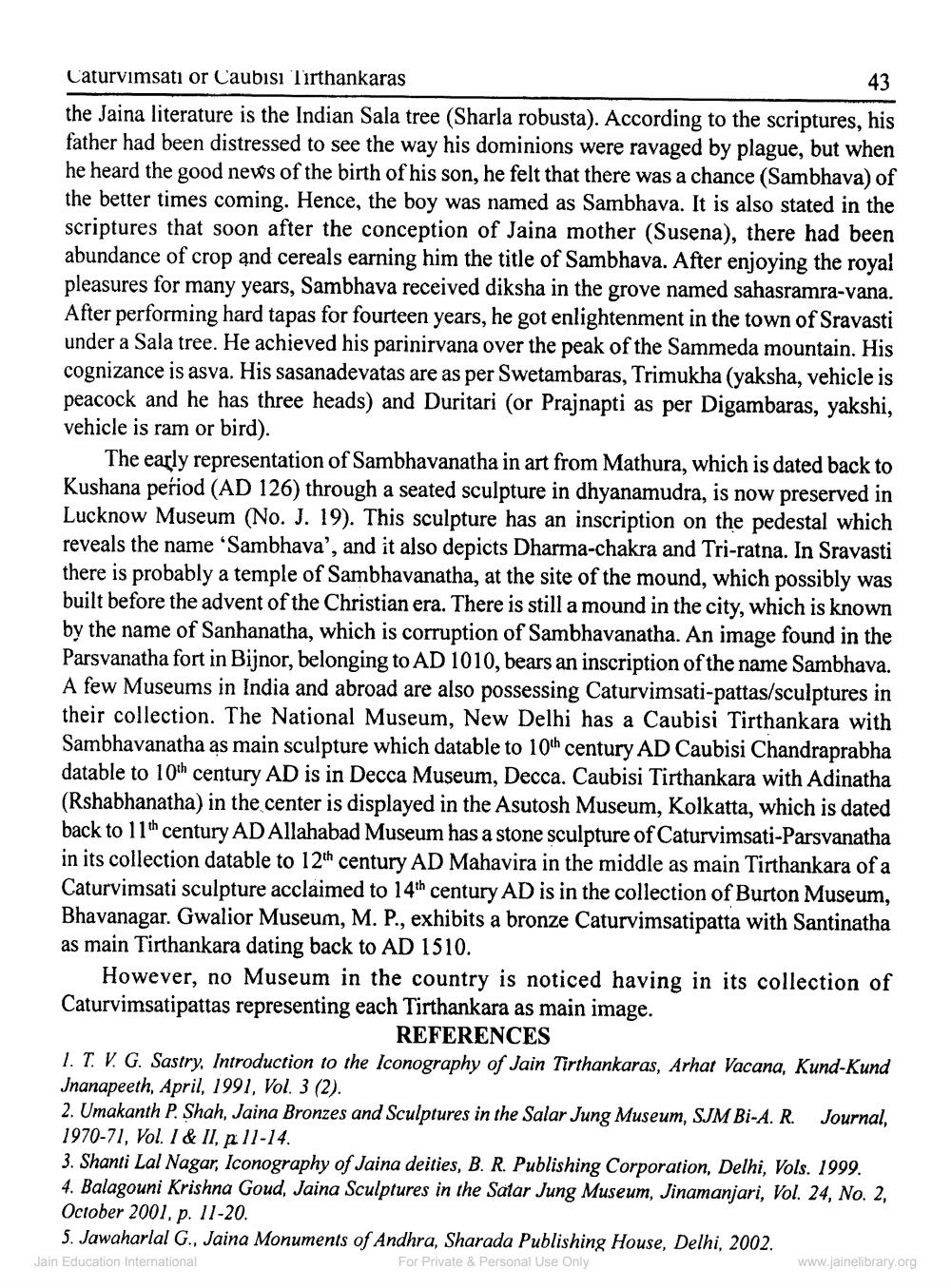________________
Caturvımsatı or Caubisi Tirthankaras
43
the Jaina literature is the Indian Sala tree (Sharla robusta). According to the scriptures, his father had been distressed to see the way his dominions were ravaged by plague, but when he heard the good news of the birth of his son, he felt that there was a chance (Sambhava) of the better times coming. Hence, the boy was named as Sambhava. It is also stated in the scriptures that soon after the conception of Jaina mother (Susena), there had been abundance of crop and cereals earning him the title of Sambhava. After enjoying the royal pleasures for many years, Sambhava received diksha in the grove named sahasramra-vana. After performing hard tapas for fourteen years, he got enlightenment in the town of Sravasti under a Sala tree. He achieved his parinirvana over the peak of the Sammeda mountain. His cognizance is asva. His sasanadevatas are as per Swetambaras, Trimukha (yaksha, vehicle is peacock and he has three heads) and Duritari (or Prajnapti as per Digambaras, yakshi, vehicle is ram or bird).
The early representation of Sambhavanatha in art from Mathura, which is dated back to Kushana period (AD 126) through a seated sculpture in dhyanamudra, is now preserved in Lucknow Museum (No. J. 19). This sculpture has an inscription on the pedestal which reveals the name 'Sambhava', and it also depicts Dharma-chakra and Tri-ratna. In Sravasti there is probably a temple of Sambhavanatha, at the site of the mound, which possibly was built before the advent of the Christian era. There is still a mound in the city, which is known by the name of Sanhanatha, which is corruption of Sambhavanatha. An image found in the Parsvanatha fort in Bijnor, belonging to AD 1010, bears an inscription of the name Sambhava. A few Museums in India and abroad are also possessing Caturvimsati-pattas/sculptures in their collection. The National Museum, New Delhi has a Caubisi Tirthankara with Sambhavanatha as main sculpture which datable to 10th century AD Caubisi Chandraprabha datable to 10th century AD is in Decca Museum, Decca. Caubisi Tirthankara with Adinatha (Rshabhanatha) in the center is displayed in the Asutosh Museum, Kolkatta, which is dated back to 11th century AD Allahabad Museum has a stone sculpture of Caturvimsati-Parsvanatha in its collection datable to 12th century AD Mahavira in the middle as main Tirthankara of a Caturvimsati sculpture acclaimed to 14th century AD is in the collection of Burton Museum, Bhavanagar. Gwalior Museum, M. P., exhibits a bronze Caturvimsatipatta with Santinatha as main Tirthankara dating back to AD 1510.
However, no Museum in the country is noticed having in its collection of Caturvimsatipattas representing each Tirthankara as main image.
REFERENCES
1. T. V. G. Sastry, Introduction to the Iconography of Jain Tirthankaras, Arhat Vacana, Kund-Kund Jnanapeeth, April, 1991, Vol. 3 (2).
2. Umakanth P. Shah, Jaina Bronzes and Sculptures in the Salar Jung Museum, SJM Bi-A. R. Journal, 1970-71, Vol. I & II, p 11-14.
3. Shanti Lal Nagar, Iconography of Jaina deities, B. R. Publishing Corporation, Delhi, Vols. 1999. 4. Balagouni Krishna Goud, Jaina Sculptures in the Satar Jung Museum, Jinamanjari, Vol. 24, No. 2, October 2001, p. 11-20.
5. Jawaharlal G., Jaina Monuments of Andhra, Sharada Publishing House, Delhi, 2002. For Private & Personal Use Only
Jain Education International
www.jainelibrary.org




